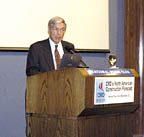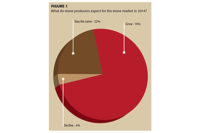
Construction industry analysts and economic forecasters delivered bad and good news at CMD’s 6th annual North American Construction Forecast conference at the National Press Club in Washington, DC, held on October 16. According to speakers, the remainder of 2001 and much of 2002 will see declines in construction activity and the economy in general. But most presenters also predicted a quick recovery by 2003.
According to Bill Toal, chief economist for the Portland Cement Association, the U.S. construction industry can expect an overall decline of 6.3% in activity next year due to the economic downturn. Still, he pointed out that "by historical contrast, this would put construction spending back to slightly above 1998 levels, which were record levels of activity."
"We expect a 10% decline in private, nonresidential construction spending next year after a 5.4% drop this year," Toal said. However, he said this sector should begin recovering by the end of 2002 and experience a 3.5% increase in 2003. "The weaker areas of non-residential construction are hotels, industrial, office and retail," Toal said. "The technology sectors, which fell about 20% in growth in the first two quarters of 2001, will hold down the office markets. Office vacancies, for example, had been predicted to rise to about 10% by the end of this year, but we may see a greater rise in vacancies going into next year."
The weakening in consumer confidence and increase in unemployment have contributed to declines in residential building. "Along with expected drops in consumer spending, home sales will most likely fall," Toal said. As a result, residential construction will decline by 8.5% next year after finishing this year with a 1.2% increase. The sector should recover sufficiently by 2003 to see a 5.8% growth rate. Housing starts will be at about 1.6 million for 2001, following 1.93 million starts in 2000. Next year, the residential markets will have about 1.485 million housing starts.
Looking ahead to 2003, Toal said construction activity will rebound sufficiently to achieve an increase of 3.8%. "Confidence levels will take a year to recover, so we’ll have a hole in the overall economy [for 2002], but by the latter part of next year, we’ll be out of the hole," he predicts.

The NAHB perspective
David Seiders, senior staff vice president and chief economist for the National Association of Home Builders (NAHB), shed light on the effects of September 11 on home buying and building by forecasting only a temporary dip in activity. Seiders’ organization has surveyed its members several times since the attacks. A telephone poll the weekend immediately following the events "revealed that the industry was holding up amazing well; people were going ahead with signings," he said.However, several weeks later, a mail survey came back with results that were starting to look gloomy: 35% of builders said their sales were off by 10%, and 22% of respondents said sales were off 5 to 10%. The main reason in both was the loss in consumer confidence. Two thirds of respondents also said traffic through potential properties had decreased, and 20% said contract cancellations were up to some degree.
By early October, the NAHB monthly Housing Market Index survey revealed a drop of 8 points from 56 to 48. An accompanying supplement showed that 56% of builders polled said new home sales had declined in the wake of the terrorist attacks.
Still, Seiders stressed that this index number puts the home building industry about where it was in the mid-’90s. "[The decline is] not that bad -- like baby talk compared to the ‘80s and early ‘90s," he said. "If it pans out the way we have mapped, we’ll see a brief and mild setback [for the remainder of 2001.]" This setback will be followed by a slow recovery that will begin as early as next year, Seiders said.
Seiders’ optimism is based in part on today’s clearer picture of the industry. At the end of the 1990s, he explained that residential market analysts were somewhat puzzled. In 1998 and 1999, the industry was seeing huge housing production numbers, with starts pushing the 2 million mark. Yet at the same time, census figures revealed the population was not growing at a rate that could absorb the supply. "This provoked discussion of overbuilding and un-sustainable levels of production," Seiders explained. Yet vacancies were not rising. The mystery was solved with the 2000 census, which revealed the government had "substantially under-counted population and household growth." There were 200,000 more households coming into existence each year than estimated, partly due to an under-estimated net immigration flow.
By the fall of 2000, the U.S. economic slowdown was in progress, but as Seiders pointed out, it began with the Federal Reserve tightening monetary policy to purposely slow down a rapidly growing economy in late 1999 and early 2000. In 1999, Seiders had predicted the home building market would bottom out by mid-2001. In reality, energy prices, the rapid retreat of the stock market, the fall of the technology sector and other factors made the rest of 2000 and much of 2001 a darker picture than originally envisioned. Moreover, the situation was exacerbated by the terrorist attacks.
The government and legislators have stepped in to provide stimuli that should keep the slide in the homebuilding market to a two-quarter event, Seiders said. In the meantime, there are positive trends occurring in the housing industry. The upward trend in house sizes and numbers of amenities continues to rise, making housing values rise at about 5% per year, which is well above inflation levels. Also, as a result of the stock market woes, "the perception of housing as an investment has strengthened in the last year," Seiders said.
Commercial outlook
In examining real estate cycles, there are two distinct factors to examine, according to Glenn Mueller, Ph.D., a professor at the John Hopkins University Real Estate Institute and a Real Estate Investment Strategist for Legg Mason, Inc. The first is the physical cycle of demand and supply, and the second is the financial cycle of where capital is flowing.The demand-and-supply cycle is local in nature, explained Mueller, and different cities across the U.S. are at different points in their cycles. For example, in the office market cycle analyses, Washington, DC, San Diego, Los Angeles and parts of New York -- as well as a host of other metropolitan areas -- are in the "hyper supply" stage of their cycle. They are experiencing increasing vacancies, but new construction is still occurring. Dallas, Jacksonville, Tampa and Salt Lake City, however, have bottomed out. They have low or negative demand growth, and construction starts have greatly slowed, but completions are still occurring. They have actually entered a recession stage in their office market cycle.
In the industrial market, none of the nation’s major cities had yet entered the recession stage at the end of the second quarter. But in the hotel market, most are moving toward that stage, and some markets -- including Charlotte, Cleveland, Indianapolis, Philadelphia, Phoenix and Portland -- have already entered it, Mueller reported.
Still, although physical market cycles are local, some general macroeconomic trends will affect the entire building industry in the early 2000s. On the demand side, population growth at a rate of about 2.4 million people every year for the next decade will keep demand rising for all property types, Mueller said. Baby boomers are at the highest income earning years of their lives; thus a second home market wave is occurring among the most populous age group -- 40- to 55-year-olds. Meanwhile, their echo boom children are just entering the job and apartment rental markets.
On the supply side, Mueller pointed out that construction labor had been the hardest to find in 2000, but that situation is easing rapidly this year. Meanwhile, material costs are increasing, and the nation’s infrastructures have not been expanded, which restricts new approvals and thus new construction.
One trend that has occurred in the last few years, and should continue into the next few years, is that more efficient capital markets have matched supply levels more closely to demand levels, following two decades of mismatch, Mueller said. What the two cycles mean in view of September 11 has yet to be determined, but Mueller had some predictions. He said demand growth will be stable but slower, and once supply growth slows to match it, equilibrium will return. For most of the construction industry, Mueller said a growth phase should begin in either late 2002 or early 2003. As far as the capital markets, fear will play a role, but how great a role will depend on how long the fear lasts. He also predicted that public market real estate debt will be more acceptable to people and that Real Estate Investment Trusts will play an increasing role in the real estate capital markets.
Another view of the commercial real estate market was presented by Ray Owens, research officer and senior economist for the Federal Reserve Bank in Richmond, VA. He reported that the market is weak in most regions of the country, a fact he attributed to the anemic high technology sector. Relative to a decade ago, however, he stated that the commercial real estate sector appears sound.
Net absorption of office space in the U.S. has fallen dramatically since early 2000. Meanwhile, office space available for sublease started to rise and has taken a dramatic leap upward in 2001 in most metropolitan areas.
Owens explained that the early 1990s found the commercial real estate sector in worse condition -- the economy was in a recession just as the commercial real estate market was feeling the effects of a giant "overhang." That overhang was caused by a spate of commercial building brought on by favorable depreciation write-offs created by the Economic Recovery Tax Act in 1981. The incentives were later removed in the Tax Reform Act of 1986.
"The U.S. economy was dramatically overbuilt at the same time balance sheets were weakened," Owens said. At the time, economists predicted it would take 10 to 15 years for the overhang to disappear, but by the mid-1990s vacancy rates fell below the 10% level for the first time since 1984.
In the late 1990s, the growing technology workforce needed more office space -- about 20 million square feet were built between 1998 and 2000. Then "the year 2000 party came to an end," Owens said. The stock market plunged, high-technology companies started to go belly up, and metropolitan areas again saw vacancy rates climb into the double digits.
As a specific example, Owens highlighted the situation in Northern Virginia, which he said mirrors the rest of the country. In this region, between 3.5 and 5.5 million square feet of space available for subleasing hit the market between 2000 and 2001, and the area recorded its first negative net absorption amount (500,000 square feet) in years during the first quarter of 2001. Average office vacancy rates reached 8%, which is lower than current vacancies in some areas of the country such as the Mid-Southwest (16%), the Southeast (14%) and the Midwest (13%).
Anecdotal evidence from mid-2001 suggests the shakedown is not yet over. However, while vacancy rates are higher than those in the 1990s, that decade had extraordinarily low rates compared to most others. Also, the broad financial woes the banking industry experienced in the late ‘80s and early ‘90s are absent in the present scenario. Finally, Owens pointed out there is a lesson to be learned from how wrong economists were about the last great overhang.
"We know activity [in commercial real estate] will be sluggish in the near future," he said. "The key question is how long will that future be?" As a result of the September 11 attacks, he said the Washington, D.C./Northern Virginia corridor has seen the strongest rebound as the Pentagon and other federal agencies aggressively lease office space available due to the dot-com meltdown.
Across the rest of the country, he said that the recent events appeared to have weakened the sector further, but the weak period, "doesn’t appear to be terribly long".
Future trends
Taking a look at building direction in the future, an assembly of construction industry leaders held a panel discussion at the conference. Moderated by Jim Cramer of Greenway Consulting, the panel included Edward Friedrichs, FAIA, president and CEO of Gensler; Pat Priest, managing director/CFO of the Beck Group; Ray Messer, PE, president and chairman of the board for Walter P. Moore; Harold Adams, FAIA, chairman of RTKL; and Stephen Fiskum, COO of Hammel Green and Abrahamson.These industry panelists said that speed of delivery was the most common factor for their current construction projects. "Clients are delaying the decision to build until the very last hour, then expecting rapid deployment of the design and delivery stages," said Gensler.
Additionally, Priest noted that the trend may mean some basic changes in processes. "We see early signs of changes in the underlying process of the business," she said, indicating a reevaluation of the design/engineer/estimate/construct process. Instead of operating in different silos, the members of the construction team -- such as the designer and the estimators -- are working together, sometimes in the same facility, to create efficiencies as well as "better design, quicker turnaround, better prices and fewer surprises," she said.
Other trends mentioned include:
* The nation’s deteriorating high-way infrastructure is creating job opportunities for some construction companies, said Messer. In particular, the North American Free Trade Agreement (NAFTA) has had a huge impact on the need for better infrastructure in Texas. Some clients are nervous about the economic situation and are not paying proper attention to their own buildings’ infrastructures. As an example, he cited building owners in the Houston area who now view the floods last spring as unique. "They are talking about putting switch gears back into basements," Messer said.
* Adams noted that while the rest of the world is experiencing slowdowns in construction activity, China is a hot market for his company. "We see China as a big part of our future," he said. Also, RTKL just received a contract to help re-build parts of the Pentagon.
* RTKL, like most firms, "is tightening up ship" in expectation of worsening conditions next year. "We’re going into next year somewhat scared," Adams said. "We are still on budget, but are prepared to be flexible because of the uncertainties of the market."
* Fiskum, as well as several other panelists, noted that his company’s backlog is shrinking. "Our backlog is down 80% from a year ago," he said. Competition is up as well, evidenced by a recent pre-proposal meeting where 70 firms showed up to get information. Fiskum says one of today’s greatest challenges is to keep expenses down and to "broaden the existing pond" instead of looking for new places to invest in the marketplace. "The challenge is: don’t whittle away at that strong balance sheet," he said. He expects to see staff turnover plummet this year.
* Several panelists foresee that training and education -- as well as technology and communication within firms -- will be vital in the coming years. "The most important factor right now is a sharing of expert knowledge across the firm," Friedrichs said. To accomplish that, his firm is highly networked. "Employees have the ability to get in touch with someone with the knowledge they need when they need it," he explained. The firm also created a series of educational programs and has an active internship program with a local university.
* Priest said her firm "has a strong commitment to innovation." "Until now, technology has had a superficial effect on our business," she said. "But now we are close to a highly intelligent system that can provide real time design and estimating."
* Sustainability and green building are coming to the forefront, according to several panelists. Friedrichs said many design firms have been slipping green building and sustainable concepts quietly into design for years. "Today, we are able to bring it out of the closet," he said, adding that the events of September 11 may accelerate the process. "People are now saying, ‘Let’s look at what’s important. If we’re going to build it, let’s do it right.’ "
In another session, Edward Feiner, FAIA, chief architect with the U.S. General Services Administration, said public architecture no longer consists of "finding ways to build great boxes," like most federal buildings used to be. Many old buildings are being retrofitted for a more modern look, as well as better building security and seismic protection. Feiner said the events of September 11 and the bombing of the Oklahoma City federal building will not frighten government building in downtown areas.

